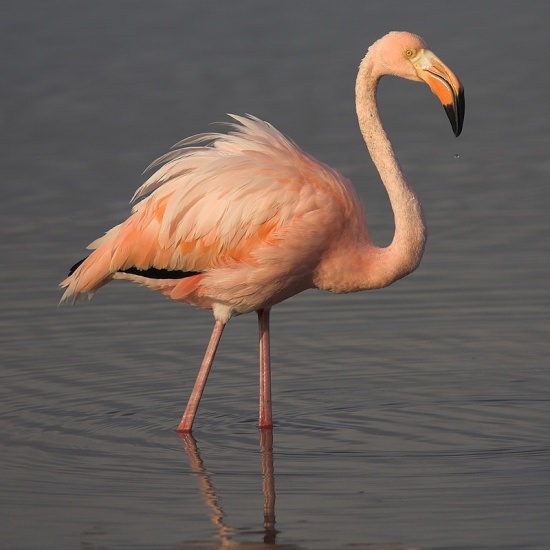| Line 1: | Line 1: | ||
| + | [[Image:Caribbean_Flamingo.jpg|thumb|550px|right|Photo by Momo. Locality: Isla Floreana, Galapagos, Ecuador]] | ||
;[[:Category:Phoenicopterus|Phoenicopterus]] ruber | ;[[:Category:Phoenicopterus|Phoenicopterus]] ruber | ||
| − | + | '''Alternative name: American Flamingo''' | |
| − | + | ||
| − | + | ||
==Identification== | ==Identification== | ||
| + | 120-145 cm. Deep pink- orange plumage, bill - black tip, red-orange middle, pale yellow near eye, long neck and legs, light yellow iris. | ||
==Distribution== | ==Distribution== | ||
| − | [[Caribbean]] and [[Mexico]] to [[Brazil]] and [[Galapagos Islands Ecuador]]. Within the Caribbean probably most numerous in [[Cuba]] and [[Bahamas]] | + | [[Caribbean]] and [[Mexico]] to [[Brazil]] and [[Galapagos Islands Ecuador]]. Within the Caribbean probably most numerous in [[Cuba]] and [[Bahamas]]. |
==Taxonomy== | ==Taxonomy== | ||
Often considered conspecific with the [[Greater Flamingo]] (''Phoenicopterus roseus'') of [[Europe]], [[Asia]], and [[Africa]]. | Often considered conspecific with the [[Greater Flamingo]] (''Phoenicopterus roseus'') of [[Europe]], [[Asia]], and [[Africa]]. | ||
==Habitat== | ==Habitat== | ||
| − | + | Shallow lagoons. | |
| − | == | + | ==Behaviour== |
| − | Breed in large colonies | + | Breed in large colonies; both sexes build the mound shaped nest from mud and twigs. 1 white egg is laid, and incubated by both parents for 27-31 days. |
| + | |||
| + | |||
| + | The diet includes small crustaceans, molluscs, and insects. | ||
| + | |||
==Bird Song== | ==Bird Song== | ||
<flashmp3>Phoenicopterus ruber (song).mp3</flashmp3><br /> | <flashmp3>Phoenicopterus ruber (song).mp3</flashmp3><br /> | ||
''[[Media:Phoenicopterus ruber (song).mp3|Listen in an external program]]'' | ''[[Media:Phoenicopterus ruber (song).mp3|Listen in an external program]]'' | ||
| + | |||
| + | ==References== | ||
| + | Colorado Education | ||
==External Links== | ==External Links== | ||
Note: Results in photo search may include photos of ''Phoenicopterus roseus'', which previously was considered a subspecies of this species (''see Taxonomy''). | Note: Results in photo search may include photos of ''Phoenicopterus roseus'', which previously was considered a subspecies of this species (''see Taxonomy''). | ||
{{GSearch|Phoenicopterus+ruber}} | {{GSearch|Phoenicopterus+ruber}} | ||
[[Category:Birds]][[Category:Phoenicopterus]] | [[Category:Birds]][[Category:Phoenicopterus]] | ||
Revision as of 14:13, 19 January 2009
- Phoenicopterus ruber
Alternative name: American Flamingo
Identification
120-145 cm. Deep pink- orange plumage, bill - black tip, red-orange middle, pale yellow near eye, long neck and legs, light yellow iris.
Distribution
Caribbean and Mexico to Brazil and Galapagos Islands Ecuador. Within the Caribbean probably most numerous in Cuba and Bahamas.
Taxonomy
Often considered conspecific with the Greater Flamingo (Phoenicopterus roseus) of Europe, Asia, and Africa.
Habitat
Shallow lagoons.
Behaviour
Breed in large colonies; both sexes build the mound shaped nest from mud and twigs. 1 white egg is laid, and incubated by both parents for 27-31 days.
The diet includes small crustaceans, molluscs, and insects.
Bird Song
<flashmp3>Phoenicopterus ruber (song).mp3</flashmp3>
Listen in an external program
References
Colorado Education
External Links
Note: Results in photo search may include photos of Phoenicopterus roseus, which previously was considered a subspecies of this species (see Taxonomy).




